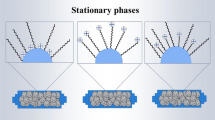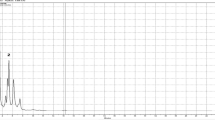Abstract
The relative performance of the binary mobile phase in the high-performance liquid chromatography analysis of carbonyl compounds (CCs) was tested using the liquid-phase standards containing 15 aldehyde/ketone–DNPH mixture. The Hichrome column was employed for the analysis of CCs at a flow rate of 1.5 mL min − 1. The binary mobile phases prepared using both acetonitrile/water (AW) and a possible alternative of methanol:water (MW) mixture were examined by their calibration results. The data derived from these two binary phases were then evaluated in terms of three key variables (i.e., resolution, relative sensitivity, and retention time). The relative water content (or the water to organic solvent ratio (W/A) or (W/M)) of the binary phase was found as the key variable for the performance. The results indicate that the optimal resolution of AW combination was attained consistently for most composition, while MW generally suffered from overpressure problem. The changes of water content in the AW mixture led to the changes of all three variables in the quantitative analysis of CCs. The obtained results confirm that the AW mixture should be the optimal elutant for the CC analysis, as other simple binary compositions like MW are limited in many respects.
Similar content being viewed by others
References
Baez, A. P., Belmont, R., & Padilla, H. (1995). Measurements of formaldehyde and acetaldehyde in the atmosphere of Mexico city. Environmental Pollution, 89(2), 163–167.
Bakeas, E. B., Argyris, D. I., & Siskos, P. A. (2003). Carbonyl compounds in the urban environment of Athens, Greece. Chemosphere, 52, 805–813.
Büldt, A., & Karst, U. (1999). N-methyl-4-hydrazino-7-nitrobenzofurazan as a new reagent for air monitoring of aldehydes and ketones. Analytical Chemistry, 71, 1893–1898.
de Carvalho, A. B., Kato, M., Rezende, M. M., de Pereira, P. A. P., & de Andrade, J. B. (2008). Determination of carbonyl compounds in the atmosphere of charcoal plants by HPLC and UV detection. Journal of Separation Science, 31, 1686-1693.
Dolan, J. W. (2002). Peak tailing and resolution. LCGC Europe. LC Resources Inc., Walnut Creek.
Feng, Y., Wen, S., Chen, Y., Wang, X., Lu, H., Bi, X., Sheng, G., & Fu, J. (2005). Ambient levels of carbonyl compounds and their sources in Guangzhou, China. Atmospheric Environment, 39, 1789–1800.
Fung, Y.-S., & Long, Y. (2001). Determination of carbonyl compounds in air by electrochromatography. Electrophoresis, 22, 2270-2277.
Grosjean, E., Grosjean, D., Fraser, M. P. , & Cass, G. R. (1996). Air quality model evaluation data for organics. 2. C1-C14 carbonyls in Los Angeles air. Environmental Science & Technology, 30, 2687–2703.
Herrington, J. S., Fan, Z. H., Lioy, P. J., Zhang, J. (2007). Low acetaldehyde collection efficiencies for 24-hour sampling with 2,4-dinitrophenylhydrazine (DNPH)-coated solid sorbents. Environmental Science & Technology, 41, 580–585.
Ho, K. F., Lee, S. C., Louie, P. K. K., & Zou, S. C. (2002). Seasonal variation of carbonyl compound concentrations in urban area of Hong Kong. Atmospheric Environment, 36, 1259–1265.
Ho, D., & Kim, K.-H. (2010) Evaluation of ternary mobile phases for the analysis of carbonyl compound derivatives using high-performance liquid chromatography. The Scientific World Journal. doi:10.1100/tsw.2010.231.
Hounoune, B., LeBris, T., Allou, L., Marchand, C., & Le Calve, S. (2006). Formaldehyde measurements in libraries: Comparison between infrared diode laser spectroscopy and DNPH-derivatization method. Atmospheric Environment, 40, 5768–5775.
Jakober, C. A., Charles, M. J., Kleeman, M. J., & Green, P. G. (2006). LC-MS analysis of carbonyl compounds and their occurrence in diesel emissions. Analytical Chemistry, 78, 5086–5093.
Kim, K.-H., Hong, Y.-J., Pal, R., Jeon, E.-C., Koo, Y.-S., & Sunwoo, Y. (2008). Investigation of carbonyl compounds in air from various industrial emission sources. Chemosphere, 70, 807–820.
Koivusalmi, E., Haatainen, E., & Root, A. (1999). Quantitative RP-HPLC determination of some aldehydes and hydroxyaldehydes as their 2,4-dinitrophenylhydrazone derivatives. Analytical Chemistry, 71, 86–91.
Liu, L.-J. S., Dills, R. L., Paulsen, M., & Kalman, D. A. (2001). Evaluation of media and derivatization chemistry for six aldehydes in a passive sampler. Environmental Science & Technology, 35, 2301–2308.
Long, W. J., & Henderson, J. W. (2008). Rapid separation and identification of carbonyls compounds by HPLC. Aligent Technologies, Inc. 5989–7483EN.
McNeff, C. V., Yan, B., Stoll, D. R., & Henry, R. A. (2007). Practice and theory of high temperature liquid chromatography. Journal of Separation Science, 30, 1672-1685.
Moussa, S. G. , El-Fadel, M., Saliba, N. A. (2006). Seasonal, diurnal and nocturnal behaviors of lower carbonyl compounds in the urban environment of Beirut, Lebanon. Atmospheric Environment, 40, 2459–2468.
Mukund, R., Kelly, T. J., Gordon, S. M., Hays, M. J., & McClenny, W. A. (1995). Status of ambient measurement methods for hazardous air pollutants: An EPA-sponsored survey points out the need for continued methods development for the Clean Air Act. Environmental Science & Technology, 29(4), 183A-187A.
Ochs, S. M., Fasciotti, M., Barreto, R. P., de Figueiredo, N. G., Albuquerque, F. C., Massa, M. C. G. P., et al. (2010). Optimization and comparison of HPLC and RRLC conditions for the analysis of carbonyl-DNPH derivatives. Talanta, 81(1–2), 521–529.
Pal, R., Kim, K.-H., Hong, Y.-J., & Jeon, E. C. (2008). The pollution status of atmospheric carbonyls in a highly industrialized area. Journal of Hazardous Materials, 153(3), 1122–1135.
Pang, X., & Mu, Y. (2006). Seasonal and diurnal variations of carbonyl compounds in Beijing ambient air. Atmospheric Environment, 40, 6313–6320.
Pires, M., & Carvalho, L. R. F. (1998). An artifact in air carbonyls sampling using C18 DNPH-coated cartridge. Analytica Chimica Acta, 367, 223–231.
Possanzini, M., Palo, V. D., Petricca, M., Fratarcangeli, R., & Brocco, D. (1996). Measurements of lower carbonyls in Rome ambient air. Atmospheric Environment, 30(22), 3757–3764.
Possanzini, M., Palo, V. D., Brancaleoni, E., Frattoni, M., & Ciccioli, P. (2000). A train of carbon and DNPH-coated cartridges for the determination of carbonyls from C1 to C12 in air and emission samples. Atmospheric Environment, 34, 5311–5318.
Possanzini, M., Tagliacozzo, G., & Cecinato, A. (2007). Simultaneous determination of formic acid and lower carbonyls in air samples by DNPH derivatization. Journal of Separation Science, 30, 2460–2465.
Prieto-Blanco, M. C., Iglesias, M. P., López-Mahía, P., Lorenzo, S. M., & Rodríguez, D. P. (2010). Simultaneous determination of carbonyl compounds and polycyclic aromatic hydrocarbons in atmospheric particulate matter by liquid chromatography–diode array detection–?uorescence detection. Talanta, 80, 2083–2092.
Uchiyama, S., Matsushima, E., Aoyagi, S., & Ando, M. (2004). Simultaneous determination of C1- C4 carboxylic acids and aldehydes using 2,4-dinitrophenylhydrazine-impregnated silica gel and high-performance liquid chromatography. Analytical Chemistry, 76, 5849–5854.
Wang, B., Lee, S. C., & Ho, K. F. (2007). Characteristics of carbonyls: concentrations and source strengths for indoor and outdoor residential microenvironments in China. Atmospheric Environment, 41, 2851–2861.
Weng, M., Zhu, L., Yang, K., & Chen, S. (2009). Levels and health risks of carbonyl compounds in selected public places in Hangzhou, China. Journal of Hazardous Materials, 164, 700–706.
Zegota, H. (1999). High-performance liquid chromatography of methanol released from pectins after its oxidation to formaldehyde and condensation with 2,4-dinitrophenylhydrazine. Journal of Chromatography A, 863, 227–233.
Author information
Authors and Affiliations
Corresponding author
Rights and permissions
About this article
Cite this article
Ho, D.X., Kim, KH. Effect of HPLC binary mobile phase composition on the analysis of carbonyls. Environ Monit Assess 180, 163–176 (2011). https://doi.org/10.1007/s10661-010-1779-7
Received:
Accepted:
Published:
Issue Date:
DOI: https://doi.org/10.1007/s10661-010-1779-7




